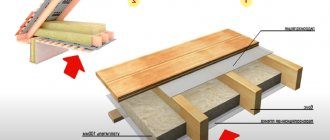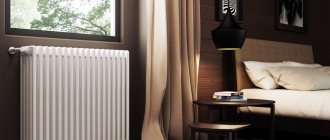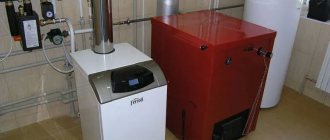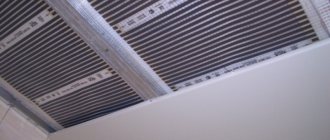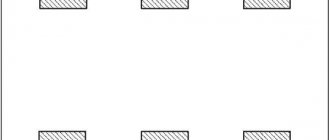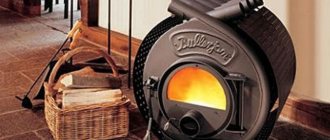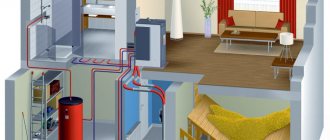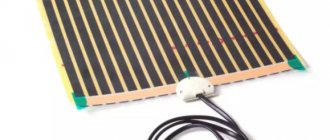Heating a home with electricity is considered the most expensive, but if other types of fuel are not available, it is worth considering the most popular types of heaters powered from an outlet. Infrared ones are considered the most economical. Their efficiency is much higher due to a different operating principle. Unlike conventional electric reflectors or radiators, infrared ones heat not the air, but the surrounding objects: the floor, walls, furniture, people. Heated objects release heat evenly, creating a feeling of comfort and dryness.
Infrared heating heating ceiling ZEBRA EVO-300
The film heater Zebra EVO-300 was developed in Chelyabinsk and is constantly being improved. This is a modular type heater, which gives advantages during installation. The film electric heater is sold in two versions: in a box (50 segments with an area of 15 square meters of material in a single tape) or in sections of standard sizes ranging from 0.6–6 meters in length. The Chelyabinsk heater ZEBRA EVO-300 will require a significantly smaller area of electric heaters - only 60% of the heated area.
Appearance of ZEBRA EVO-300:
1. Branch wires (phase, neutral);
2. Ground contact;
3. ZEBRA EVO-300 branded emblem and laminated sticker indicating the working side of the heater;
4. Heating elements;
5. Fields for fastening;
Specifications:
• Rated voltage Un – 220 V, 50 Hz;
• Maximum power – 220 W/sq.m;
• Rated load current In – 1 A/sq.m;
• Max. heating temperature ZEBRA EVO-300 45-50°C;
• Thickness of the canvas – no more than 1 mm.
Size range of ZEBRA heater:
• Length – from 0.6 to 6 m;
• Width – 0.5 m.
Each segment of EVO-300 is a full-fledged heating element with a power of 66 W, which effectively operates from a 220V electrical network. Infrared heating based on ZEBRA EVO-300 can become the main source of heat in any room. Heating is carried out with minimal energy consumption and extremely quickly, which is facilitated by the unidirectionality of the radiation of the heaters.
In addition to the standard EVO-300 ST series, the improved ZEBRA EVO-300 PRO series has become available, capable of generating 10% more thermal energy with the same power consumption. The manufacturer's warranty for ZEBRA EVO-300 is 10 years, the estimated service life is at least 25 years. You can view prices for turnkey installation of ZEBRA EVO-300 here.
Water type IR ceiling panels
The design is a system of insulators and reflectors that direct energy to specified areas of the room. Water heated to a certain temperature circulates through pipes enclosed in an aluminum shell. The liquid is heated in the block, and heat is distributed into the room due to the active movement of water through the pipes.
During the hot season, coolant circulates through the pipes, making it possible to create a comfortable room temperature all year round.
Water-type infrared heating has the following advantages:
- adjustable heating level;
- possibility of local heating;
- safety for human health;
- low power consumption;
- silent operation;
- ease of installation;
- possibility of remote control;
- versatility (you can heat the room or cool the air temperature).
Ceiling water IR panels have a significant drawback - high cost.
Warm ceiling
- The main advantage of a warm ceiling
- Lack of a warm ceiling
- Installation of a warm ceiling
The main advantage of a warm ceiling
So, the most important argument in favor of using infrared heating is precisely the low power of this type of heating compared to other heating systems.
For example, the power of a water heated floor system averages 50-80 W per square meter. And the power of films for ceiling heating devices, declared by the manufacturer, is 15 W. This is certainly great. But it's not that simple.
To mount a heating film on the ceiling, it is necessary to mount the lathing, mount heat-insulating mats, mount a reflector layer, and only then mount the heating film.
At the same time, you need to understand that heat loss from your home or premises should be minimal. Otherwise, energy consumption when using a warm ceiling will be comparable to traditional heating systems.
This is of course cheaper than a device, for example, a concrete warm water floor system. But the quality is the only plus.
Lack of a warm ceiling
If you have warm water floors, then they can be heated with any boiler. For example, electric, gas, diesel, solid fuel, heat pump, solar collector and so on.
But infrared heating film works only on electrical energy. Thus, if the electricity is turned off, you will be left without heating.
According to the heating principle, warm ceilings and warm floors are the same. Both of these systems operate in the long-wave infrared heating range.
Therefore, I would not consider warm ceilings as the main heating. As an alternative please. For example, you turn on warm ceilings during the day while you are at work. And at night, turn on the stove or turn on another boiler.
It is also convenient to use ceiling heating in the off-season to maintain a comfortable temperature in the house without turning on the main heating.
Installation of a warm ceiling
When installing a heating film on the ceiling, it is necessary to pay attention to the quality of the connection between the supply cable and the film and the reliable insulation of this connection, since water leakage from the roof or upper apartments cannot be ruled out. And if the connection is poorly insulated, you may get an electric shock or a fire may occur due to a short circuit with water.
And if the connection is poorly insulated, you may get an electric shock or a fire may occur due to a short circuit with water.
The next rule when installing a warm ceiling is the permissible installation of a finished ceiling at a distance of no more than 100 mm from the heating film.
In this case, the thickness of the finished ceiling materials should not exceed 20 mm.
In addition to all of the above, the heating film for installing a warm ceiling differs from the film for installing a warm floor.
The film for a warm ceiling is equipped with additional reflective elements, which in turn allow the installation of warm ceilings with a height of no more than 4 meters.
To summarize the above, it is advisable to use warm ceilings in well-insulated buildings and premises as alternative heating or in the off-season.
It is also convenient to use warm ceilings with an uninterrupted supply of electrical energy. Although today no one will give guarantees for uninterrupted supply.
And to provide basic heating, you can use radiator heating systems, heated floors or any other system.
If you have questions about the installation of underfloor heating systems, then follow the links and you will receive comprehensive answers on the installation of water or electric underfloor heating. published econet.ru
If you have any questions on this topic, ask them to the experts and readers of our project here.
Coating IR film for ceiling outside
When choosing IR film for heating a room, you need to pay special attention to the quality of the system, which must meet a number of basic parameters:
- the base must be made of high quality film, the polymer used must be fireproof;
- the conductive strip must be undamaged and made of copper materials, the minimum permissible width must be 15 mm;
- the silver strip must have a clear outline, without gaps, and it must overlap the copper bus by 2 mm;
- the arrangement of carbon emitters should be striped or solid; geometric shapes do not have any effect on the operation of the ceiling heating system;
- the external lamination of the infrared film must be made of the same polymer as the base; it is not recommended to use materials with a smaller thickness;
- standard films must withstand temperatures up to +80 °C, high-temperature materials - up to +110 °C;
- if high quality materials were used in the production process, then there should be no deformation during operation;
- high-quality IR film should heat up evenly in a short period of time - about 5-10 seconds.
As practice shows, the wider the film, the lower the likelihood of it overheating during operation.
Important! If the polymer is transparent, then it deforms much faster during operation.
Installation of film heating on the ceiling
In order for the finished heating system to be effective, the following rules should be followed when operating:
- Before installation, you need to insulate the room (walls, doors, windows).
- Do not install film heating in a room with high humidity or low temperature.
- The heating system, which acts as the main one, must occupy at least 80% of the total ceiling area. For additional, 40% is enough.
- The current power must correspond to the value specified in the heating system passport. If it is less than required, it is necessary to install a distribution block.
- The temperature sensor should be installed at a level of 170 cm from the floor level.
- It is prohibited to bend the roll-up heater at an angle of 90°.
- For ceilings that are too high - above 360 cm - standard models are not suitable, since the energy consumption in this case will be unreasonably high.
- In order to reduce heat loss, it is recommended to install foil film under the IR film. It will reflect heat into the room.
- The roll heater should only be cut along the marked lines.
- The IR heater must be fixed using a stapler or special fasteners, and the fasteners should be located on the transparent areas of the film.
- The distance between film strips should be no more than 50 mm.
- During installation, you must ensure that the heating surfaces will not come into contact with flammable or combustible materials.
- Electrical wiring contacts must be carefully insulated using insulating tape and plastic caps.
Film infrared heating is installed in four stages:
- Calculation of materials for the installation of a film heating system.
- Carrying out work on thermal insulation of the ceiling.
- Installation of heating system elements, installation of a temperature sensor.
- Connection to the network and thermostat.
After determining the required amount of materials and purchasing them, they begin to insulate the ceiling. To do this, use a foil-coated heat insulator (folgoizol penofol and others). The material should be reinforced over the entire surface of the ceiling and extend slightly onto the walls to reduce heat loss.
An IR film is mounted on top. Fix it on the fasteners included in the kit, positioning it so that it falls on the places marked for cutting - this way the heating elements will not be damaged.
When the film is fixed, it is necessary to insulate the contacts on one side and connect the wires on the other. Then you need to install a thermostat on the wall. Testing the operation of the system. If it works as expected, move on to finishing.
IR film can be covered with various finishing materials: MDF, plastic lining, plasterboard and others. The main thing is that they do not have heat-reflecting properties.
Heating a home with infrared heaters is a modern alternative to traditional electrical systems. Its high cost is justified by ease of use, ease of installation, reliability and efficiency.
Efficiency and economy are the main indicators when choosing infrared ceiling heating. The cost of energy sources is high, and many owners of private houses try to use them rationally. These two indicators form the basis for the creation of a unique and modernized IR heating system. How does this system work and is it possible to install it yourself?
Ceiling infrared heating
Selection of panels and their installation in the apartment
The power of panels for a home is selected at the rate of 1 kW per 20-25 cubic meter of space. Knowing the dimensions of the room, it will not be difficult to calculate which panels will be required for it.
If heating radiators are already installed, and the panels will play a secondary role, it is necessary to reduce the power and choose the most compact equipment. The efficiency of such heaters reaches 90%: this means that they use electricity as efficiently as possible, so their installation will be much more efficient than the installation of conventional radiators or convectors.
To heat the coolant in the system, not only electricity can be used. Gas heating will be much cheaper, and if this is possible, you can consider connection options. The coolant will be heated in the exchanger, and then flow through pipes into the panels, which will distribute soft heat throughout the room. However, this is a rather complicated option: equipping a conventional system with a heating element is much easier.
Externally, the wall panel is a thin plate; it can have different sizes. You can purchase regular products, or you can order designer panels, whose outer surface will be decorated with bright multi-color designs.
Such products can be placed in any part of the room, and they will look good in the interior. Having chosen a place to install the panels, you can proceed directly to installation:
A kit is purchased, which, in addition to the panel itself, includes a cable, a thermostat and a sensor system that will allow you to monitor the temperature in the room. With their help, it will be possible to maintain a stable heating level, which will be regulated without human intervention. In this case, you can select several panels that differ in power: thanks to the operation of the thermostat, they will be able to maintain the optimal temperature regime. You need to determine the location for the panels. The best option is walls between the windows: this will allow the warm flow to be directed into the room, and the radiation will ensure uniform heating. You can hang them on the walls like paintings, or install them on the ceiling in accordance with the design project. A set of sensors and a thermostat are installed in the room, the system is connected by cable into a single unit and connected to the network. The cable can be put into a box and mounted on the wall to give the room a neat appearance.
Installation usually takes a minimum of time; even a home craftsman who has not previously worked with such systems can easily install such panels. Manufacturers provide their products with detailed instructions describing how the system operates. You can calculate at which point in the room it is consistently coldest, and that is where it would be appropriate to place the infrared thermal panel.
If self-installation causes difficulties, it is better not to take risks, but to seek the help of a specialist. In addition, it is advisable to protect the electrical network from sudden voltage changes using stabilizers. Infrared panels negatively tolerate sudden increases and decreases in the electrical system, so they can fail for a long time even with a single failure.
An important advantage of such panels is their versatility. Equipment of the required power can be selected not only for a living room, but also for a production workshop, assembly hall, or any other large room in which uniform heating can be ensured on all sides
Thanks to high energy efficiency, it will be possible to minimize heating costs and at the same time create the most comfortable environment in the room.
You need to enable JavaScript or update your player!
Myths and facts about PLEN ceiling heating
PLEN heating technology is quite new, and many myths have appeared about it. How true are the popular claims about this heating system?
| Myth | Fact |
| Ceiling heating creates a “warm floor” effect | A wavelength of 9-15 microns when passing 250 cm (usually ceilings are located at this distance from the floor) cannot heat the floor to a temperature of 36 degrees or higher |
| The film helps maintain optimal humidity and fights mold | Infrared radiation cannot affect humidity and does not kill mold |
| Installation will cost significantly (up to 70%) less than installation of water and other heating systems | Not true. The installation of ceiling PLEN heating will cost about the same as convector heating |
| The heat produced by this heating system is more comfortable for humans | According to manufacturers, the optimal temperature under film heaters is about 18 °C. But this does not affect comfort in any way. |
| Long (up to 50 years) service life | Since the technology is quite new, this statement cannot be verified in practice. |
| The film can be covered with any finishing material, excluding metallized | Then most of the rays will heat the finish |
| Film infrared heating is the most economical of all infrared heating systems | PLEN is much higher than other IR heaters |
| PLEN turns on only for 3-15 minutes per hour, due to which electricity consumption is 7 times lower than when operating an electric boiler or convectors | This mode of operation is capable of heating a room and maintaining an acceptable air temperature in it only if the house is insulated so well that heat loss is reduced to almost zero. This is usually not the case, and PLEN will have to work much more often |
| The system is absolutely safe | A breakdown may form in the film |
| No permits are required for installation and operation of the system. | It is necessary to document the allocation of the specified electrical power and update the electrical network if it does not meet the requirements |
Features of ceiling heating systems
Installing film heaters on the ceiling allows you to obtain the following operating scheme. When the device is turned on, it emits infrared waves aimed straight down. The radiation goes towards the floor and is most absorbed by it. The remaining waves affect furniture and other interior items. As a result, they all begin to work harmoniously and then give off heat. The maximum temperature in the room will be at floor level. At a height of 1.7 m it will be several degrees lower. This temperature distribution is ideal for human health and well-being.
If you want to combine a suspended ceiling and PLEN, then experts advise additionally installing a protective layer of plasterboard. It will absorb the remaining heat, and the stretched film will remain unchanged. Another advantage of installing film heaters on the ceiling is the minimal risk of their sudden deformation.
Design and principle of operation of an infrared heater
The steel body of the device contains a reflector and a heating element or emitter. When plugged into the network, the emitter heats up and emits infrared waves, which are perceived by humans as heat. The heating element can be made in the form of a heating element - a tubular heater, an open or closed spiral, or a carbon coating in film heaters.
The reflector serves for directional heating and protection of the device itself from overheating. Infrared waves are completely safe for humans and animals, except for possible overheating. To prevent it, heaters are equipped with thermostats and sensors. With their help, you can set the heating temperature and turn off the device when it is reached.
Types of infrared films
From a design point of view, all IR films are similar and have a common operating principle. However, for various types of premises and operating conditions, it is customary to use certain options for film heated floors. The differences between ICs are primarily due to the fact that they are produced by different companies.
Let's consider the types of IR film based on maximum heating temperature and their compatibility with various floor coverings:
high-temperature infrared heated floors under tiles. The maximum heating temperature of such systems reaches 50°C. They are incompatible with floor coverings that are more susceptible to heat (linoleum, laminate);
In their structure and principle of operation, all infrared films are similar to each other, the main difference is the maximum heating temperature
- low-temperature infrared heated floors for linoleum and laminate. Such systems can heat up to 27°C;
- universal IR systems that are compatible with all types of floor coverings.
The second parameter by which IR films are classified is the type of heating element. Today, there are two main types of infrared floors, depending on the heating element:
- carbon;
- bimetallic.
The power density of the infrared floor is the last indicator, which is very important when choosing heating. Let's consider three main types of IR films, depending on this parameter:
with low power (130–160 W/m²) - used in cases where it is necessary to organize heating of a room with a small area. Compatible with “light” floor coverings;
Infrared films from different manufacturers may differ in appearance and technical parameters
- with average power (from 170 to 220 W/m²) - installed in more spacious rooms. Perfect for the following flooring options: porcelain stoneware, tiles;
- with high power (above 220 W/m²) – installed in industrial buildings. They are also used for floor heating in saunas and various workshops.
Features of carbon and bimetallic IR films
Carbon films used for underfloor heating are more expensive. The heating elements in such a system are made of a special carbon material, which has a fibrous structure. In some cases, they are equipped with a protective layer of graphite. Spraying of this material helps to increase the strength characteristics of the system and also affects the length of its service life.
The basis of the material is represented by lavsan film. Carbon infrared film flooring can be mounted on horizontal and vertical surfaces.
Scheme of bimetallic infrared film for heating
Bimetallic IR film differs from carbon film in that it has heating elements consisting of two metal layers (aluminum and copper). The material is based on double polyurethane film, which has good elasticity.
The installation of a bimetallic system is complicated by the fact that a ground electrode cannot be connected to the system. Also, the bimetallic structure is incompatible with ceramic flooring. It belongs to the low-temperature variety, so its recommended heating level does not exceed 27°C.
What is infrared heating
Infrared (IR) heating works differently than the more familiar convector heating. The emitted waves heat up objects - walls, floors, ceilings, furniture - and from them the air in the room heats up. A person located in a room heated by infrared radiation is enveloped in heat from all sides, including from the floor. For this reason, the level of comfortable temperature decreases by a couple of degrees, which means that under the same conditions, heating costs will be lower.
The difference between traditional types of heating and infrared
However, miracles do not happen and only heating a house in which heat loss is minimized will be economical. Under such conditions, naturally, all heating costs will be lower, including any electric ones. But with IR heating, a lower temperature is actually required. The second reason for saving is the presence of a thermostat. If equipped, the heaters operate for a short period of time when the room temperature drops below the set temperature. Otherwise, the heaters are on all the time, the room is hot, you have to open the windows, and the electricity bills are high (to put it mildly).
Infrared heating can be used as the main one, or as an additional one to create more comfortable conditions in a specific place - near the desk, in a relaxation area, etc.
Where can heaters be located?
Infrared heating of rooms is organized by separate heaters or film surfaces, which are mounted in the floor, walls or ceiling. Ceiling heating (film on the ceiling) is popular due to its analogy with solar natural heating. Radiation directed from the ceiling is evenly distributed over the surface of the room and causes heat transfer from all objects in it. Furniture, dishes, walls, and baseboards become heating radiators.
Despite the ceiling location of the heating source, the warmest zone is located near the feet. Since the ceiling is free of any objects, it can be completely used for installing infrared film.
For floor and wall heating, the film is installed only where there is no furniture or household appliances. On the one hand, this reduces the cost of heating installations, on the other hand, it reduces the amount of emitted energy.
Operating method of infrared heating
In the environment, infrared radiation is present in the spectral region of electromagnetic waves that are emitted by the sun. Thanks to this invisible wave range emitted by it, all living things live and develop on our planet. Scientists divide infrared radiation into three components:
The most productive for heating and safe for living organisms are considered to be electromagnetic waves that go immediately beyond the visible red side of the mid-range. The emission wavelength spectrum varies from 8 to 12 microns. It is the long-wavelength wavelength that developers use when creating infrared equipment and heating systems. Infrared installations are something like the sun in miniature
The only distinguishing feature from the sun is that they constantly heat the room, no matter what the weather is like outside.
Functioning of infrared heating
They operate in domestic conditions from a 220V network. The heating element, which is considered the main part of the device, distributes light radiation. Thanks to the reflector, at the time of operation, the object at which the device is aimed is heated. The role of receivers and emitters can be played by different objects in the room: furniture, windows, floor, ceiling, living organisms. These objects take heat into themselves or transfer it into space.
At the time of operation of the infrared heating system, all surfaces of interior parts in the place of radiation are 10 degrees warmer than the surrounding air. Heating with infrared rays works ideally with other traditional heating options, thanks to which, at minimal cost, you can create a piece of warmth in any room - a place of increased comfort. This type of heating is convenient to use as additional or emergency heating. Heat consumption when using it is no more than 10%.
Conclusion
Infrared heating is a new product on the modern market with great potential. Despite the fact that this technology was invented at the beginning of the last century, it is only now that it is being actively used for heating rooms. In the construction of large facilities, such heating is simply irreplaceable, because it significantly saves energy, is convenient to install and use, and has a number of other advantages. It is safe to say that this is the technology of the future, since in the context of the desire to reduce energy consumption, infrared heating is a big and bold step towards the goal.
Request a call
On-line calculator
Advantages and disadvantages of infrared warm ceiling
Compared to other types of heating systems, a warm ceiling has many advantages:
- the greatest efficiency compared to conventional radiators and reflectors;
- the natural level of humidity is maintained in the room;
- simple installation and absence of labor-intensive operations;
- simple automatic control will allow you to forget about temperature changes;
- possibility of installation in buildings of any type, including wooden ones;
- wide selection of final ceiling finishes.
The only significant drawback is the limitation in ceiling heights, but even in this case you can get out of the situation. For example, when installing thermal film, go around those places where people are constantly: above the head of the bed or above the workplace.
Film heaters
Film IR heaters are devices used for general or partial heating of a room. They consist of film, foil and heating elements that produce long-wave infrared radiation. The devices also have special sensors that turn off the system when the air temperature reaches a predetermined level, and when it drops below the minimum acceptable level, the heater is activated. Thanks to this, electricity is saved - the device does not just work.
Some film heaters have thermostats with the ability to program the temperature for 24 hours. In this case, while there are no people in the room, the IR device does not turn on, and some time before the owners return, the device starts working and manages to warm up the house. However, such heaters cost significantly more than simple models.
Air heating system
The most modern heating option in the house. Eliminates the use of liquid from the heat generation chain.
Such systems include:
- air purification filters;
- air heating systems;
- exhaust ventilation;
- fresh air ventilation with heating control.
But you should understand that converting a house to use such systems is a very costly and time-consuming task. Design takes into account not only indicators such as heat release and heat loss, but also the amount of noise from the units and the location of furniture. But at the same time, directly heating the room solves the issue of air purification.
The simplest diagram of heat converters looks like this: heater-air-consumer. At each stage, energy losses are inevitable, so the main principle in such systems is to reduce the heat conversion chain.
Do-it-yourself warm ceiling is simple and affordable
To create comfortable living conditions in the house, it is necessary to solve the issue of maintaining heat in it. In addition to thermal insulation of the floor and walls of the house, it is also necessary to insulate the ceiling. Over 50% of the heat can escape through it. A warm ceiling in the house will reduce heat loss and reduce heating costs during the cold season.
Roof and ceiling insulation scheme.
To do this job correctly, you need to know how to do it? You can insulate it in 3 ways:
- from inside the premises;
- outside (from the attic);
- using the method of combined insulation (inside and outside).
Various materials can be used as thermal insulation. The most common ones are:
- various types of mineral wool (rolled or in the form of slabs);
- expanded polystyrene;
- expanded clay;
- warm slag;
- sawdust;
- insulating mixtures based on clay and various polymer impurities.
Scheme of insulation, vapor barrier and ventilation of a residential attic.
Making a warm ceiling with your own hands is not difficult. First you need to measure its area and prepare the necessary material. To complete the work you will need the following material and tools:
- insulation material;
- vapor barrier film;
- waterproofing material;
- bars measuring 50x50 mm;
- wood hacksaw;
- knife for cutting insulation;
- perforator;
- hammer;
- dowels;
- screws and nails;
- construction stapler.
External insulation
Insulation of the attic from the inside and outside.
If the attic in the house is not used as an attic space, the best option would be to install external insulation from the attic side. To do this you need:
- Clear the attic of debris.
- Cover the surface with waterproofing material.
- Install logs at the height of the insulation being laid (for loose insulation about 200 mm high, for mineral wool or foam plastic about 100 mm high). If the insulation is laid in the form of slabs, the logs are installed to their width.
- The space between the joists is filled with insulation up to the top edge or filled with insulation boards (polystyrene or mineral wool). Sawdust mixed with lime or clay can be used as an insulating material.
- The surface of the laid layer is covered with a vapor barrier film.
- A subfloor is installed on top of the logs, so as not to damage the installed insulation layer and vapor barrier.
Insulation from inside the room
Diagram of the main heat losses of buildings.
It must be taken into account that when installing an insulating layer from inside the room, the ceiling height will decrease by its thickness. The best option is to install insulation when creating suspended or suspended ceilings. In this option, the insulating material is placed between the ceiling and the ceiling finishing surface.
Mineral wool in the form of slabs is used as insulation when used indoors. It can be attached to the ceiling surface using 2 methods: using glue or inside the frame. When gluing, the following work order must be observed:
- The inner surface is cleaned from whitewash to concrete.
- A layer of primer (thinly diluted glue) is applied to the base.
- Glue is applied to the concrete base, a slab of insulating material is pressed against the base with force and held for 15 seconds. All other plates are attached in the same way.
- The gaps between the plates are filled with polyurethane foam; after the foam has dried, the protruding pieces are cut off with a sharp knife.
- A vapor barrier film is attached to the surface.
- A polymer mesh is glued to the surface, the surface is puttied, cleaned and then finished.
When installing inside the frame, the work order is as follows:
- To install a suspended ceiling, a frame is installed. The frame joists are attached in increments equal to the width of the insulation boards.
- Mineral wool is inserted between the joists.
- The gaps are filled with polyurethane foam. After it dries, the protruding parts of the foam are cut off.
- A vapor barrier film is installed on top of the installed layer.
- Drywall sheets are installed on the frame.
- The surface is being prepared for finishing.
An insulated ceiling will create comfortable living conditions in the house, significantly reduce heat loss and save money on energy bills.
Information about the film
Materials and tools for film installation
Infrared carbon film is intended for heating. The principle of operation is the emission of infrared rays. It consists of a non-woven fabric, which is covered on each side with a plastic film. Heat transfer is 100 percent. This high figure is achieved due to the use of a carbon fiber layer and a pair of copper busbars.
High flexibility expands the range of applications of infrared film. Installation and dismantling is easy. The product does not require additional surface leveling.
The film consists of:
- Heater.
- Special foil.
- Double-sided film lamination.
How do infrared film ceiling heaters work?
Infrared film heaters
When the question arises about heating their own home, ordinary people are looking for ways to create a system that would be cheap, but at the same time work efficiently using less fuel. We will not consider all types of heating devices offered by manufacturers today, but will focus on just one. This is an infrared ceiling film heater. Why him?
IR heaters appeared on the market not very long ago. They have not gained much popularity only because consumers are somewhat wary of new products. This is the first. The second is a volatile device that operates from an electric current network. You yourself know how our networks work, especially outside the city. Blackouts occur with enviable regularity, so we are still afraid to use infrared film heaters as the main source of heat.
Connection
It’s not hard to figure out how to connect an infrared heater - it operates on a 220-230 V network, so the simplest and most obvious way is to plug it into an outlet. At least, mobile models are connected to sockets.
Panels or film systems are connected to each other in parallel, then connected to the thermostat (control panel), after which the wire (phase, neutral and ground) is pulled directly to the machine located in the distribution panel. This allows you to bypass all the wiring brought into the apartment or house. Most often, a separate automatic machine is installed to heat the apartment, which is triggered when there is a heavy load or a short circuit. The rest of the wiring in the apartment is connected to another machine. This allows you to correctly distribute the loads generated during the operation of infrared heaters. If you “hang” a powerful heating system on the existing apartment wiring, then when the heating system and, for example, an electric oven, air conditioner or iron are operating simultaneously, overloads are possible. In rare cases, this leads to a fire, although most often automatic devices are triggered.
However, to create a cozy warm corner with a small number of panels with a total power of up to 2 kW, it is possible to connect an infrared heater to an outlet, that is, the general electrical wiring in the house.
Selection of materials
When choosing, you must be guided by the following characteristics:
- the material must be safe;
- it is necessary to choose a material with non-flammable impregnation;
- The environmental properties of the material are very important, your home should be environmentally friendly;
- try to purchase materials from a reputable manufacturer.
Slag, expanded clay, mineral wool, glass wool - choose depending on the humidity of the room, its volume and your preferences. Consultants will help you make a specific choice if you tell them about your problems and challenges. You will be guided by the amount of materials required for the size of your home, shown the necessary certificates and given explanations for installation.
How to insulate a ceiling with your own hands
Solving this issue will allow the owners to save on heating and live in comfortable conditions, having a warm private home.
To begin with, professionals lay glassine, which protects the insulation from moisture and rot, attaching it to the ceiling beams. Then the foam is laid. The gaps between the sheets are sealed with ordinary polyurethane foam. Glassine is placed on top of it again. Only after this do they begin laying the insulation. Thanks to such good insulation, your insulation will last for many years and will not be susceptible to mold and rot. And thanks to this, the ceiling can be repaired less often. We tried to reflect the entire insulation process in photos that will help you repair the ceiling yourself.
Tips for owners
If you really want to have a warm private home, then listen to our advice. It is better to lay the insulation in two layers, then the ceiling will be well insulated and the house will be warm. The upper layers of insulation should cover the lower joints, so your ceiling will be perfectly insulated. Wooden boards can be placed on top of the insulation, which will press the material, ensuring solidity and reliability, and they will make it durable. You can see photos of the correct installation of insulation in several layers
Also pay attention to how insulated your ceiling is on the outside of the house, because heat loss also depends on this. If insulation is needed outside, it is carried out according to the same scheme, only instead of the top layer of boards, roofing material is used, and on top - tiles or any other material
At the end of the insulation process, you will immediately feel that the microclimate around has changed, your house is warm and without drafts, which just recently walked through the cracks.
The insulation procedure may seem long and complicated at first glance, but once you try, you will learn to do it with the necessary skill and in the next room you will do it easier and faster. The reward for your efforts will be a warm, cozy home where the whole family will feel calm and comfortable.
Benefits or harms of infrared radiation
Most of those who are thinking about installing infrared equipment in their home have questions about the safety of such a system.
First, let's figure out what infrared radiation is. These are electromagnetic waves of a certain length. Their natural source is the Sun, which emits a large number of waves of different spectrums. The longest ones are the so-called red ones, because the human eye sees them as red.
However, scientists have proven that there are also infrared waves, the length of which is slightly longer. They belong to the waves of the spectrum invisible to humans. They get on the skin and are felt as a thermal effect. But not all infrared radiation is created equal.
Physicists distinguish three groups of such waves:
- Short , emitted by bodies with temperatures above 800 °C.
- Average _ They are emitted by objects heated to 600 °C.
- Long . Emitted by bodies with temperatures up to 300 °C.
Depending on the wavelength, infrared radiation affects living organisms differently. Short waves penetrate deep enough into the human body and can warm up the internal organs.
In areas of the skin that have been exposed to short infrared waves, redness, blisters and even burns form. Medium-length waves have a milder effect, but are still undesirable for the body.
Film heaters heat up to a temperature of 50C, accordingly they emit only long infrared waves, useful for humans
Long-wave infrared radiation is perceived by humans as pleasant warmth. It penetrates the upper layers of the skin and gently warms up the moisture in them. This is why all living organisms love to bask in the sun.
Long-wave infrared radiation not only warms, but also activates the immune system, triggers restoration and regeneration mechanisms for many systems and organs.
Considering that film equipment heats up to 45-50C, you can be sure that it emits long infrared waves. In the operating mode of maintaining the set temperature, the system operates on average from 6 to 10 minutes per hour.
Thus, it has a short-term effect on humans. The safety of PLEN is confirmed by many certificates. It is recommended for installation in medical and children's institutions.
Detailed information about the dangers of infrared heaters is discussed in our other article.
Types of infrared heating
A heating system based on infrared radiation can be:
They differ not only in design, each type has its own characteristics.
Ceiling infrared heating systems
This type of heating system is installed on the ceiling, with the heat flow directed to the floor. The floor covering heats up, releasing heat into the air and warming up the room.
Infrared ceiling lamps consist of:
- aluminum reflective plates;
- base heating element;
- thermostatic sensors.
The system produces electromagnetic waves that turn into thermal energy. The productivity of the system depends on the material from which the base element is made. The most effective are quartz, tungsten and ceramic heating elements.
- ease of installation and dismantling;
- compactness;
- possibility of automatic control of work;
- compactness.
Heating a house using ceiling systems has the following disadvantages:
- difficulty when installing on non-standard (for example, sloping) ceilings;
- high cost of equipment;
- the need to place heaters at least 1.5 m from the floor level.
Wall-mounted IR heating systems
Wall-mounted heating devices can be made in the form of baseboards, PLEN systems, radiators, panels. Installing the EINT is simple; no experience is required: you just need to attach the brackets to the wall and hang the heater using the instructions.
- automatic operating mode;
- long service life;
- low energy consumption for heating 1 m²;
- low maintenance costs.
Wall-mounted infrared heating panels also have disadvantages:
- high price;
- the need to place devices at a given level for uniform heating of the room;
- impossibility of use as the main heating system in regions with harsh climates.
Floor infrared heating systems
IR floor heating system - thin film mats with flat heating elements. To lay them, you can use any type of screed, and use natural stone, laminate, ceramic tiles, linoleum and other coatings as finishing materials.
Installation is quick, no labor-intensive operations are required, and the result is warm floors.
- long service life;
- noiselessness;
- environmental friendliness;
- Ease of Management;
- fire safety.
The disadvantages include:
- low efficiency with poor-quality thermal insulation or its absence;
- high price;
- the need to draw up a plan for the location of the slabs, taking into account the characteristics of the room and the arrangement of furniture in it.
Installation
If such a system is planned as the only heating element, it is necessary to install mats on 70-80% of the surface.
If additional heating is provided, it is enough to cover 30% of the ceiling area. Before installing the heating film, you need to calculate the power of the total planned coverage area. This must be done to select the correct power thermostat. For example, a conventional thermostat consumes 4 kW, and 1 sq. m of film - about 0.2 kW. In this case, the area of the infrared ceiling should be no more than 20 sq.m.
Next, you need to make high-quality thermal insulation. In concrete apartment buildings, this is necessary so that heat does not escape to the neighbors above. In a wooden house, it is also necessary to insulate the beams to prevent heat dissipation in the wood and its drying out.
Foamed polystyrene in a roll, covered on one or both sides with foil, is used as thermal insulation. The material is attached to the ceiling with plastic refractory dowels. The joints are sealed with foil tape. Next, you can install an electric warm ceiling.
Infrared sheets are mounted at a distance of 20 cm from the walls. In a wooden house, it is recommended to make an indent of 30-40 cm. There should be a distance of 5 cm between the strips. Refractory dowels are also used as fasteners. Thermal film is laid parallel to each other. Installation must be calculated in advance according to the diagram, avoiding laying canvases over sleeping places and over electrical appliances (TV, microwave oven, kitchen hood, etc.)
After securing the canvases, you need to connect the system. To do this, connect terminals to the copper busbars and clamp them tightly with pliers, and the connection points are insulated. To connect the infrared bands, an electric copper wire with a cross-section of 2.5 square meters is used. mm or more. Then you need to connect the entire system to the thermostat. It is placed at a distance of 1-1.5 m from the floor. To hide the wires in the wall, you need to make a groove using a drill or hammer drill. It will need to be hidden later with plaster. The installation is ready, all that remains is to check the heating. It is better to do a “test drive” of the ceiling before sealing the grooves.
Sun on the ceiling
Those who had the opportunity to read “Three from Prostokvashino” in their happy childhood years probably remember that the stove in Uncle Fyodor’s house served purely decorative purposes. To heat the house, he used an electric sun, ordered from some research institute and nailed to the ceiling. Now it is difficult to say whether the creators of ceiling IR heaters themselves came up with their brainchild or stole this idea from the author of the famous story, but, one way or another, the electric sun turned from a fairy tale into reality. Except that its shape is not round, but rectangular.
What is a ceiling film IR heater and how does it differ from its lamp and tubular counterparts? First of all, the emitter. Instead of metal spirals and ceramic elements, thin carbon threads are used here. which are laid on a polymer film coated with carbon paste. The thickness of the latter is only 1 micron (0.001 mm), so the entire pizza-like product is placed in a durable fire-resistant shell made of laminated polyester, which acts as a reliable electrical insulator. At the edges, both layers of the shell are glued together without laying carbon fiber threads between them. The resulting empty tracks are used to mount the heater on the ceiling.
Film ceiling heater design
The heater is controlled by a thermostat. installed on the wall at a height convenient for the user, which is usually from 1 to 1.5 m. It is enough to set the desired temperature on this device, and it will turn the ceiling heater on and off at the right time. Simple and cheap thermostats have a mechanical device, more expensive ones are electronic and can be programmed.
All ceiling IR heaters are divided into three categories:
- low-temperature with emitted wavelengths from 5.6 to 100 microns and heating temperatures up to 600 degrees (minimum installation height - from 2.5 to 3 m);
- medium-temperature with a wavelength from 2.5 to 5.6 microns and a temperature from 600 to 1000 degrees (minimum height - about 3.6 m);
- high-temperature with a wavelength from 0.74 to 2 microns and a heating temperature of over 1000 degrees (installed at a height of at least 8 m).
IR films are low-temperature, long-wave devices; on average, their heating temperature is about 45 degrees.
One square meter of ceiling IR heater consumes from 130 to 200 W of electrical power, the efficiency of the device is about 95%.
A carbon heater, in our opinion, is the best tool for this purpose.
These products come in lamp, rod and film types. In the first two cases, carbon filaments enclosed in the airless space of the lamp body or rod act as a heating element.
In the film, such functions are performed by carbon paste, evenly distributed between two layers of dense polymer.
Carbon (carbon) has thermal conductivity that is several times greater than that of other materials. At the same time, it offers the least resistance to electric current.
Based on such characteristics, it can be understood that the energy consumption of such devices is minimal.
According to their main design features, IR heaters are divided into several types:
- ceiling;
- wall-mounted (both lamp and film);
- floor
All designs have their own individual sizes and shapes, but the essence of the device is always the same - the emission of infrared rays.
What are IR rays
The rays have practically no characteristics that have a detrimental effect on the human body, animals or plant structure. They do not create vibrations, noise, or burn oxygen the way other types of heaters do, but only create small electromagnetic radiation.
IR radiation does not heat the surrounding air, but when it acts on objects, it heats them up, if, of course, they are in the zone of its propagation.
It is also worth remembering the property of IR rays, which is their wavelength (9.4 microns), which completely coincides with the range of thermal radiation of the human body, or rather, the wavelength of this range (8–10 microns). This indicator is natural for a person, and this contributes to a powerful healing effect.
Many people call infrared radiation in this range “life rays.” Tested and recorded in laboratory conditions - during operation of an infrared device, molecules (so-called anions) are formed in the air. Anions are a kind of “air vitamins”; they cleanse the air of foreign odors and have a positive effect on humans, animals and vegetation from all sides.
Compared to other types of heaters, infrared heaters will save you at least 15-20% on energy consumption. And if you install a programmable thermostat, the savings will be at least 25–35%.
Which option to choose
Before you go shopping, you need to decide on the location of the heating device. I have already mentioned above that household infrared heaters can be placed on the ceiling, wall or floor.
The design features of the devices do not in any way change the main purpose, so first of all pay attention to the power of the heating element and the design of the heater in general
The power directly determines whether the device can heat the entire area of the room or not, but the design, I think, is a personal matter.
So, let's see what different types of heaters look like:
Infrared ceiling heater
The design of such devices varies, but, as a rule, does not differ much from the basic model. As a rule, this is a flat panel, rectangular in appearance, with brackets for mounting on the ceiling on the balcony. The panels have a variety of sizes, and the choice of color scheme can please any housewife.
Infrared wall heater
Here, the imagination of manufacturers led to the fact that, in addition to traditional-looking devices, heaters appeared in the form of a picture, for example. An infrared film heater is located behind the surface of the painting. Beautiful and practical. In addition, such a picture, with an area of 0.5 square meters, is quite enough to heat a small balcony.
Infrared floor heater
This type of device has the widest range of models.
Models can be vertical or horizontal, thick or thin. They come in a chrome-plated or polymer-painted body, or the “filling” is enclosed in a ceramic base.
When choosing a floor-standing option, it is necessary to correlate the area of the heated room with the power of the device, since some are so small that they cannot heat the entire room.
Film infrared heaters
There is also a variety of heaters made of carbon film. Infrared film heaters can look like a picture, for example. A heater with artistic design will fit perfectly into the interior of the balcony and decorate it.
